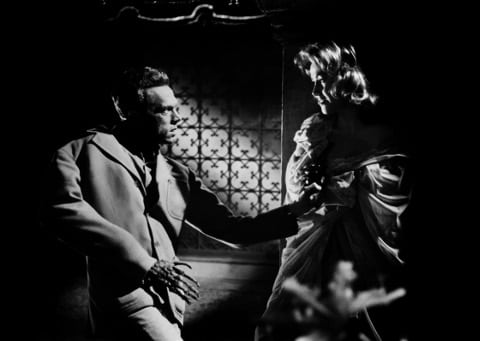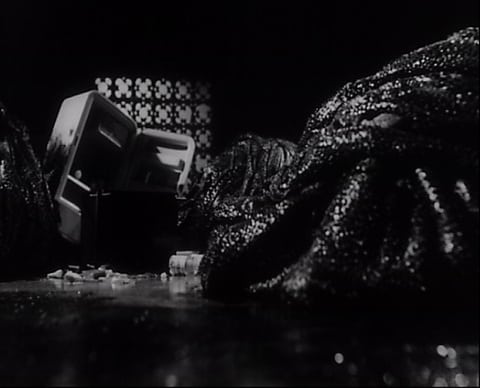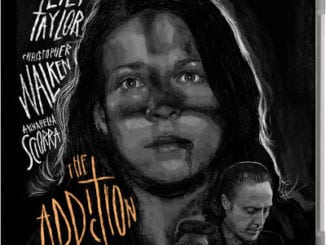Caltiki the Immortal Monster (1959)
Directed by: Mario Bava, Riccardo Freda
Written by: Filippo Sanjust
Starring: Didi Sullivan, Gérard Herter, Giacomo Rossi Stuart, John Merivale
AKA IL MOSTRO IMMORTALE, THE IMMORTAL MONSTER
Italy/USA
AVAILABLE ON DUAL FORMAT BLU-RAY AND DVD: 1oth April, from ARROW VIDEO
RUNNING TIME: 81 min/76 min
REVIEWED BY: Dr Lenera, Official HCF Critic

A group of archaeologists in Mexico find a large statue of Caltiki, the vengeful Mayan goddess who was ceremonially presented with human sacrifices. Failing to find one of their number who’s gone missing, the group sends one of their own via a cable down into the pool in front of the statue of Caltiki to find artifiacts. He finds skeletons clad in gold jewellery, but when they pull him up a second time his body has been reduced to a decayed mass over his skeleton, and a shapeless blob-like creature appears. They kill it with fire, but when they return to Mexico City one of the men has a small blob in his arm….
It was only yesterday whilst posting a news story about a third version of The Blob being far closer to actually getting made that I admitted that I had a real liking for blob movies – for me there’s something genuinely horrible and alien about such creatures, not matter how unconvincing they may sometimes look – though I’ll take tripe or rubber over computer graphics any day. And now here I am reviewing this Italian effort which is clearly inspired by the two Hammer films The Quatermass Experiment and X – The Unknown but adds a few effective touches of its own. Mario Bava’s vampire classic Black Sunday is usually considered to have begun the boom in Italian horror, and it’s possible that without its huge success we would far less likely to have been treated to the masterworks from Dario Argento, Lucio Fulci and others, but Riccado Freda actually tested the waters before with The Vampire and Caltiki The Immortal Monster. Neither made much of an impact, but their historical significance is undeniable. You can definitely see the origins of some things in The Vampire that would be developed in later Italian horror films, but Caltiki’s science fiction horror, clearly influenced by British and American’B’ monster movies, wasn’t replicated very often. It has its faults and for me [this was the first time I’d seen the film] just falls short of classic status, but it still has much to recommend it, contains some very memorable moments, and true to much of Italian horror is quite gruesome and lurid for its time.
The Vampire was completed by Bava because the film was going overbudget and Bava had attained a reputation for finishing films and solving problems with very little money. Freda was nonetheless hired to make Caltiki which was a co-production by Italy’s Lux Film, Galatea Film and independent American producer Samuel Schneider with Allied Artists supplying the two leads and distributing the film in the US. Bava did the cinematography and directed most of the scenes involving his special effects, but Freda ended up leaving this project too. The exact reasons were debated for years but Freda claimed he abandoned the film specifically so that Bava, whom he knew to be hugely talented, would get a chance at showing more of what he could do and be given a screen credit for once. It seems that shooting had nearly been completed when Freda left and Bava took over post production. I must admit that, while I certainly enjoyed the film, only sometimes did it feel like a Bava film even if it often looked like one. The house attacked by Caltiki at the end was actually a model of his father Eugenio’s real home and the miniature furniture and some other details were contributed by Eugenio himself. Shot quickly and cheaply, Caltiki became the first of many Italian horror films to employ some Anglicised credits – Freda became Robert Hampton – because Italians tended to prefer imported horror films to homegrown efforts [many of Bava’s more popular films internationally were box office failures in Italy]. The film still wasn’t the hit expected but did solid business overseas, though with five minutes of dialogue removed for its US and UK [which wasn’t until 1962] release.
A bit of opening narration tells us something that will be news to historians – that the Mayans all fled their cities in the year 607 A.D. because of their angry goddess Caltiki [rather than it being two centuries later and being probably due to a combination of drought, war and overpopulation] before the credits then tell us that the film is based on “A popular ancient Mexican legend”. Of course we know not to take this kind of thing in these films too seriously – remember that episode of Bava’s Black Sabbath that was supposedly based on a story by ‘Ivan Tolstoy’? What is impressive though are the shots of Mayan ruins which were probably done with still photographs and sheets of glass but look really realistic until an obviously fake volcano is seen erupting in the background. The first scene of a man – introduced by his hand appearing over a rock in a shot virtually repeated in Black Sunday [and with the same actor too] – staggering into the camp, traumatised and with his companion gone, is a great opening and the film then establishes the situation and the main characters economically without being too rushed. As with most US genre films of the time we have a love triangle, here involving Prof. John Fielding, his wife Ellen who feels neglected, and Max Gunther. The latter’s feelings aren’t reciprocated, though he’s adored by half breed Linda, a woman with a shady past whom he was once involved with. I found it hard to understand why she loves him so much as he treats her like crap throughout, but love is often strange. The group looks for and fails to find the missing man though a camera pan to the left reveals his corpse [they don’t look very hard], the native say that the coming of these white people has “awakened evil spirits”, one man stupidly films a ceremony which is just an excuse to show a pretty girl doing a sexy dance for a few minutes, and then they all watch some footage of the missing guy and his companion conveniently filmed by an Indian guide, footage which becomes all shaky as something seems to attack them – and we realise that we’re watching the beginnings of Found Footage before our very eyes!
We soon get a scene which must have had 1959 audiences screaming their heads off, as the guy collecting treasure at the bottom of a pool insists on being lowered down a second time, Bava’s favoured theme of greed already making an appearance. Eventually, his cable to the surface suddenly begins to move erratically. Fearing for his safety, the group pulls him back to the surface, only to find, upon removing his face mask, that his face has been reduced to a decaying mass over his skull! Great stuff that still works quite well today – though it’s followed by a silly moment where Max basically falls onto the large blob monster that begins to move around. Still, it’s all quite fast and exciting until flamethrowers kill the beast and back in Mexico City remove and isolate the small blob on Max’s arm [another good gruesome sight], after which the film starts to stall for a while. There’s much footage devoted to John trying to work out why and what, and Max going mad. Max is clearly meant to be like Victor Carroon in The Quatermass Experiment, but because unlike Victor he was never a nice guy from the start there’s no pathos and we don’t feel for the guy at all. Eventually though the film’s early pace comes back as does the blob itself for a perhaps limited [no city threatening here] but still pretty strong final section.
Of course the story, which links the immortal god Caltiki to a meteor, isn’t too well worked out, and there are a few unavoidably goofy moments, like when a night time car dash culminates in a day time shot of a car falling off a cliff [which was actually taken from an old serial I used to enjoy as a kid on TV, King Of The Rocketmen]. I had to laugh at a scene involving a gigantic early computer which is called an “electric brain”. However, while I guess some younger viewers brought up on CGI may disagree, Caltiki, consisting of butcher’s offal with an actor sometimes underneath [God what a job that must have been], looked fine to me [if not quite as nightmarish as X- The Unknown] and certainly sufficiently repulsive. There’s one great moment when it splits into several blobs using a string-like substance [maybe it was string?]. The horrific shots [there’s a rather nasty swallowing scene] look convincing and some of the models considerably less so but quite detailed nonetheless. And, while the film never really reaches the consistently high level us Bava fans are used to [and let’s not forget Freda gave us some very good movies too like The Horrible Dr Hitchcock and Murder Obssession], there are a few very well handled bits. I was highly impressed with a sequence where Max is in hospital. A dissolve focusing on his clock indicates that some time has passed, and the camera pans to his now empty bed. A nurse comes in, and I expected her to be greeted by the shock of Max being gone, but no, he re-appears to strike her with something [I couldn’t make out what it was]. In most American and even British films of the period that would have been sufficient, but he then carries on battering her several times, a scene understandably originally cut in the UK.
Bava here proves himself adept at a film noir style of cinematography with expert use of black and shadows, the most notable example of the latter perhaps being a conversation in a room where the characters are dominated by their huge shadows. Of course knowing Bava’s expertise with colour it’s perhaps a shame that Caltiki wasn’t shot in that format, though I’m not sure some of the effects shots would have worked as well. Now Bava’s films are not generally known for their good acting [though here and there certain performances stand out], and most of the performers in Caltiki are just adequate but two are definitely pretty good: Gérard Herter relishing being horrible as Max, and Daniela Rocca providing some pathos as the rather pitiful Linda [how Max can reject her in favour of Ellen is perhaps the film’s most unbelievable aspect]. The music score by Roberto Nicolosi constantly blasts away in the background and is highly reminiscent of a Universal horror score with certain cues bordering on copies, though it’s an unremarkable and sometimes slightly intrusive effort. In general though, Caltiki should reasonably satisfy as long as you don’t expect something on the lines of Bava’s or indeed Freda’s classics.
Rating: 









Caltiki The Immortal Monster‘s restoration is very good indeed, the only weak shots being some quick bits of stock footage [which is unavoidable]. The generally rather dark film always looks sharp and detailed. As would be the pattern for films like this, the film was shot mainly in English but was then dubbed into English and Italian by others. While it’s very close to the script, the English dub is a poor sounding effort except for the guy voicing Max, so the Italian soundtrack with English subtitles is a much preferable option. Arrow have done their usual great job with the special features, which here are mostly new. Arrow have treated us to two audio commentaries of the film, and they make for an interesting comparison. Both Tim Lucas and Troy Howarth have written books about Bava, and both provide fine talk tracks. Lucas, who’s been doing these for ages, provides a bit more information but is a little dryer and sounds more like he’s reading from his notes. Howarth’s track drags around the middle of the film where he goes on and on about the careers of the various people on screen, but feels slightly fresher elsewhere and even has a sense of humour in places. It also doesn’t have any gaps while the one by Lucas has quite a few. Of course both make many of the same observations, but both are definitely worth listening to.
So on to the other special features, and first we have Kim Newman talking about the film and its place in horror/science fiction film history, also giving a clear overview of where the genre was at at the time. He’s always good to listen to and is totally aware of the film’s flaws yet still really likes it. Then we have a full aperture version of the film. Bava apparently shot the effects footage open matte so when you watch the ‘normal’ version, parts of many shots are missing. I flicked through this version and you do get a much fuller view of some things, so it’s a worthwhile inclusion. Then we have two archival extras from the Italian DVD. Critic Stefano Della Casa and director Luigi Cozzi both talk for around 20 minutes about the film. Della Casa mounts a nice defence of the somewhat overlooked Freda and even tells a couple of nice stories about him. Cozzi, obviously a fan of the film, goes more into the making of and makes a good claim for screenwriter and set designer Fillipo Sanjust being the main creator of the film, and even praises the performances! Both men seem happy talking about the film with few breaks. Arrow haven’t included the Cozzi/Giona A. Nazzaro commentary track from the Italian DVD, but I doubt it’s a necessary inclusion considering what else we have here. Bravo Arrow for another excellent presentation and release of a flawed but interesting and fun movie!
SPECIAL FEATURES
*Brand new 2k restoration from the original camera negative
*High Definition Blu-ray (1080p) and Standard Definition DVD presentations
*Original mono Italian and English soundtracks (lossless on the Blu-ray Disc)
*Newly translated English subtitles for the Italian soundtrack
*Optional English subtitles for the deaf and hard of hearing for the English soundtrack
*New audio commentary by Tim Lucas, author of Mario Bava: All the Colors of the Dark
*New audio commentary by Troy Howarth, author of The Haunted World of Mario Bava and So Deadly, So Perverse: 50 Years of Italian Giallo Films
*From Quatermass to Caltiki, a new discussion with author and critic Kim Newman on the influence of classic monster movies on Caltiki
*Full Aperture version
*Riccardo Freda, Forgotten Master, an archival interview with critic Stefano Della Casa
*The Genesis of Caltiki, an archival interview with filmmaker Luigi Cozzi
*Archival introduction to the film by Stefano Della Casa
*Original Italian and English theatrical trailers
*Alternate opening titles for the US version
*Reversible sleeve featuring original and newly commissioned artwork by Graham Humphreys
FIRST PRESSING ONLY: Illustrated collector’s booklet featuring new writing by Kat Ellinger and Roberto Curti







Be the first to comment